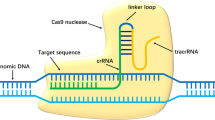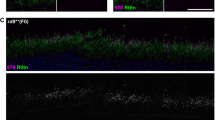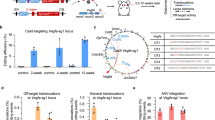Abstract
Here, we report that genome editing by CRISPR–Cas9 induces a p53-mediated DNA damage response and cell cycle arrest in immortalized human retinal pigment epithelial cells, leading to a selection against cells with a functional p53 pathway. Inhibition of p53 prevents the damage response and increases the rate of homologous recombination from a donor template. These results suggest that p53 inhibition may improve the efficiency of genome editing of untransformed cells and that p53 function should be monitored when developing cell-based therapies utilizing CRISPR–Cas9.
This is a preview of subscription content, access via your institution
Access options
Access Nature and 54 other Nature Portfolio journals
Get Nature+, our best-value online-access subscription
$29.99 / 30 days
cancel any time
Subscribe to this journal
Receive 12 print issues and online access
$209.00 per year
only $17.42 per issue
Buy this article
- Purchase on Springer Link
- Instant access to full article PDF
Prices may be subject to local taxes which are calculated during checkout


Similar content being viewed by others
References
Hustedt, N. & Durocher, D. Nat. Cell Biol. 19, 1–9 (2016).
Hohmann, S. & Gozalbo, D. Mol. Gen. Genet. 211, 446–454 (1988).
Richardson, C. D., Ray, G. J., DeWitt, M. A., Curie, G. L. & Corn, J. E. Nat. Biotechnol. 34, 339–344 (2016).
DeWitt, M. A. et al. Sci. Transl. Med. 8, 360ra134 (2016).
Yin, H. et al. Nat. Biotechnol. 32, 551–553 (2014).
Dever, D. P. et al. Nature 539, 384–389 (2016).
Lee, K. et al. eLife 6, e25312 (2017).
Maruyama, T. et al. Nat. Biotechnol. 33, 538–542 (2015).
Schmierer, B. et al. Mol. Syst. Biol. 13, 945 (2017).
Luo, M. & Chen, Y. Int. J. Ophthalmol. 11, 150–159 (2018).
Otto, T. & Sicinski, P. Nat. Rev. Cancer 17, 93–115 (2017).
Sokolova, M. et al. Cell Cycle 16, 189–199 (2017).
Doench, J. G. et al. Nat. Biotechnol. 34, 184–191 (2016).
Wang, J., Vasaikar, S., Shi, Z., Greer, M. & Zhang, B. Nucleic Acids Res. 45, W130–W137 (2017).
Canny, M. D. et al. Nat. Biotechnol. 36, 95–102 (2018).
Cuella-Martin, R. et al. Mol. Cell 64, 51–64 (2016).
Muerdter, F. et al. Nat. Methods 15, 141–149 (2018).
Li, W. et al. Genome Biol. 15, 554 (2014).
Wang, T. et al. Science 350, 1096–1101 (2015).
Tsai, S. Q. et al. Nat. Biotechnol. 33, 187–197 (2015).
Acknowledgements
Part of this work was carried out at the High Throughput Genome Engineering Facility and the Swedish National Genomics Infrastructure funded by Science for Life Laboratory (Scilifelab). The Knut and Alice Wallenberg Foundation, Cancerfonden, Barncancerfonden and the Academy of Finland supported this work. We thank H. Han and Y. Bryceson for providing equipment, the Protein Science Facility at Karolinska Institutet, as well as I. Sur and T. Kivioja for their comments on the manuscript.
Author information
Authors and Affiliations
Contributions
E.H., B.S. and J.T. wrote the manuscript. S.B., B.S. and J.P. conducted the genome-wide knockout screens. E.H., B.S. and S.B. prepared the cell lines and performed the flow cytometry experiments. J.T. and B.S. supervised the study. All authors read and approved the final manuscript.
Corresponding authors
Ethics declarations
Competing interests
The authors declare no competing interests.
Additional information
Publisher’s note: Springer Nature remains neutral with regard to jurisdictional claims in published maps and institutional affiliations.
Supplementary information
Supplementary Text and Figures
Supplementary Figures 1–5 and Supplementary Tables 1–3
Rights and permissions
About this article
Cite this article
Haapaniemi, E., Botla, S., Persson, J. et al. CRISPR–Cas9 genome editing induces a p53-mediated DNA damage response. Nat Med 24, 927–930 (2018). https://doi.org/10.1038/s41591-018-0049-z
Received:
Accepted:
Published:
Issue Date:
DOI: https://doi.org/10.1038/s41591-018-0049-z
This article is cited by
-
Genome-scale pan-cancer interrogation of lncRNA dependencies using CasRx
Nature Methods (2024)
-
Mechanistic insights into DNA damage recognition and checkpoint control in plants
Nature Plants (2024)
-
Efficient prime editing in mouse brain, liver and heart with dual AAVs
Nature Biotechnology (2024)
-
A scalable platform for efficient CRISPR-Cas9 chemical-genetic screens of DNA damage-inducing compounds
Scientific Reports (2024)
-
Recent advances in CRISPR-based functional genomics for the study of disease-associated genetic variants
Experimental & Molecular Medicine (2024)



